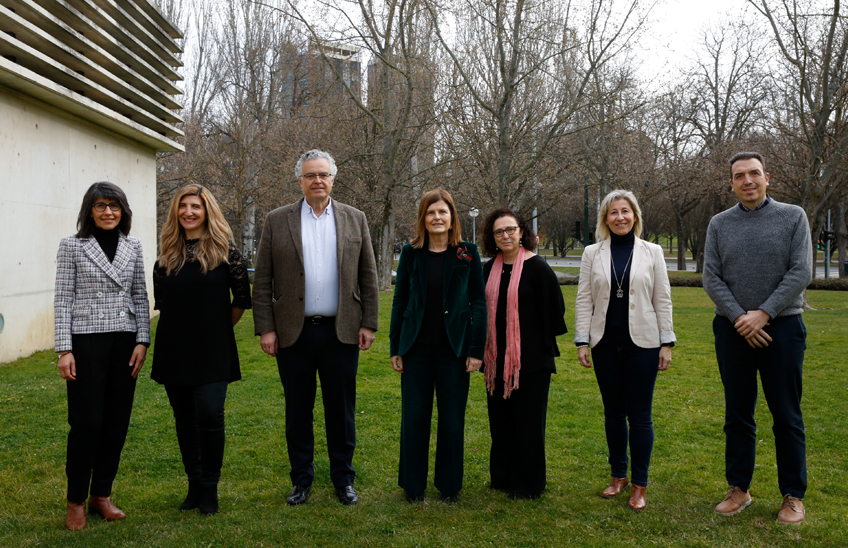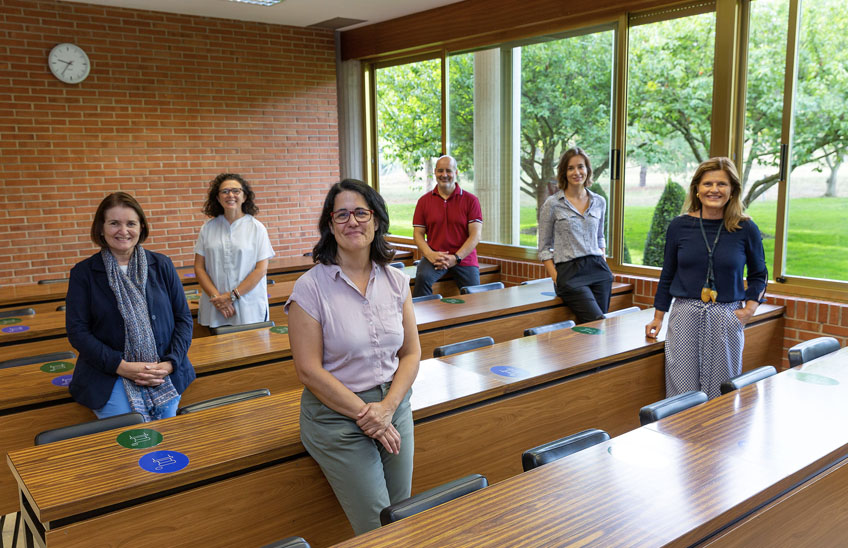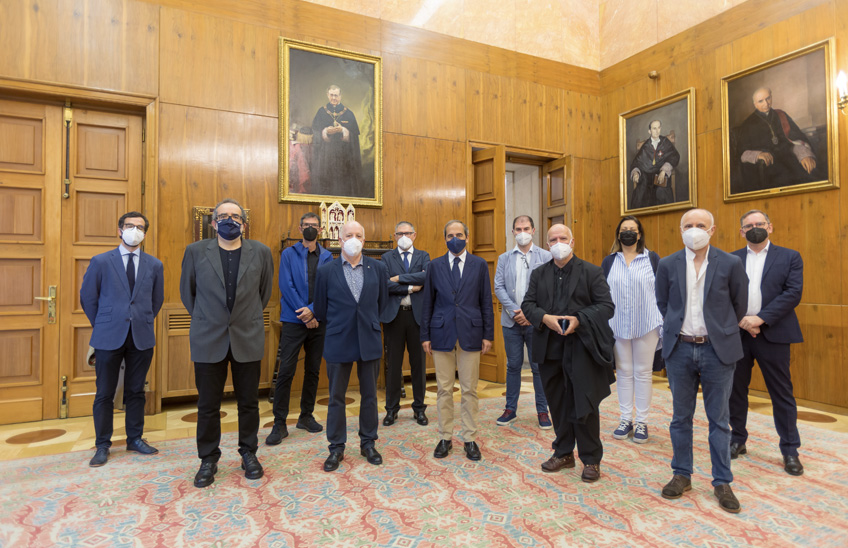The lack of sectorisation in groups of residents, lifts and ventilation are factors that influence the incidence of Covid in residences in Navarre.
The University, QPEA Forum, ASBAR-IDEA have presented the conclusions of a study measuring the impact of covid in nursing homes.

FotoManuelCastells/Researchers and participants in the presentation of project at Civican.
25 | 02 | 2022
The lack of sectorisation into groups of residents or cohabitation units, lifts, the percentage of double rooms or the subject and the effectiveness of ventilation in the building are some of the architectural factors that may have had the greatest influence on the increased risk of COVID contagion in Navarre's residential homes. These are some of the conclusions presented by project of research of the University of Navarra, Foro QPEA and ASBAR-IDEA.
Likewise, the study underlines that the management of people and spaces, and the rehabilitation of old residences could be strategic to develop a model whose focus is the integral care of the person. It has also been found that the high external incidence in the Basic Health Zone where residency program is located is correlated with a higher incidence rate in residency program.
issue The research has analysed the influence of architectural and environmental factors on the number of deaths in nursing homes in Navarre, and on their physical and psychological impact during the pandemic, in 71 nursing homes in Navarre. The work, sponsored by Fundación Caja Navarra and Fundación La Caixa, within the Navarra Solidaria programme, has been carried out through surveys designed ad hoc, discussion groups with the profiles most involved, the monitoring of environmental conditions and the data incidence and mortality data supplied by the Government of Navarra.
"Although the research has been carried out in Navarra, the results can be extrapolated to other nursing homes in Spain, and can be a good starting point for preventing and controlling future pandemics related to respiratory viruses," says Ana Sánchez-Ostiz, principal investigator of the project. She also explains that, among the general conclusions, she highlights the role of staff and the managers of the residences: "It is only fair to value the great effort they have made during these two years".
The study highlights the age and size of residency program as determining factors in cases of covid. The data obtained show that the incidence has been highest in the oldest residences and decreasing in the most modern ones. Likewise, the incidence rate has been higher in larger residences, especially in the case of infections: 329 per thousand compared to 218 per thousand in smaller ones.
Conclusions of a study multidisciplinary
According to the study, from the point of view of the architectural design the factors that have most influenced the issue of contagions are the lack of sectorisation into groups of residents or cohabitation units. "Most of the residences have floors of rooms separated from the common areas, so it is not possible to create bubble groups", they explain. Similarly, the lifts, the lack of independence between Covid/No Covid routes, the higher percentage of double rooms and shared bathrooms, the dining room and the conference room living or meeting rooms or the subject and effectiveness of ventilation in the building increase the risk. These factors are found to a greater extent in older residences.
From an environmental point of view (temperatures and indoor air quality), older residences, which only have natural ventilation, find it more difficult to control ventilation and temperatures in the right ranges. "To ensure comfort temperatures, CO2 meters are a useful measure to determine when ventilation is needed," they explain.
Among the factors core topic of the management of the pandemic in the centres is the implementation of a Person-Centred Integrated Care model as a system for reducing the risk and biopsychosocial impact of the disease on residents, as well as digitalisation and a contingency plan adapted to each residency program with follow-up and assessment.
Finally, it should be noted that the most autonomous people are those who have suffered the greatest biopsychosocial deterioration, as their attention and significant activities have been reduced. Among the wear and tear suffered by the teams of professionals, those volunteers who worked exclusively in the Covid area were particularly affected. Also, emphasis is placed on the digitalisation of the sector leave , making it difficult for residents to connect with their family and environment.
Proposals for prevention and action in the face of future respiratory disease pandemics
From the point of view of the architectural design , the researchers propose that each residency program carry out a Building Adaptation Plan that meets criteria such as designing phased living units (in case there are none), which can serve as isolation units in case of pandemic, increasing the issue of single rooms or foreseeing the modification of the residency program in phases to have at least two lifts, two staircases and two independent routes designed to current standards (widths, ventilation, lighting, etc.).
In this Adaptation Plan, the researchers also suggest the rehabilitation of the building's thermal envelope - roofs, façades and windows - and providing solar protection systems, improving the regulation and control of heating, as well as installing CO2 meters in all residences. "It is therefore very necessary for public administrations to create a specific programme of financial aid for energy rehabilitation works, accessibility and architectural criteria that can prevent the transmission of Covid in gerontological residential centres, in a similar way to the existing programmes for the rehabilitation of housing.
The researchers suggest a plan that contemplates three protocolised scenarios for action. "The first, to deal with cases in which there is a specific outbreak, the second in which there is a controlled outbreak in a sealed covid unit, and the third in which the outbreak is not controlled and it is necessary to refer it to intermediate resources and hospitals with which there is prior coordination". This protocol contemplates actions such as access control, safety distance, times of use or shifts in common rooms, etc.; and other specific actions on ventilation, visits, use of workers' spaces, implementation of improvements and changes that have worked in the management of covid, training to professionals in this contingency plan and the commitment to the model of comprehensive care of the person.
Among the proposals from the biopsychosocial perspective, it is worth highlighting the development of the implementation of model de Atención Integral de la persona to overcome weaknesses, to train and implement interdisciplinary teams, to implement measures and offer support to the team of professionals to reduce the risk of fatigue and burnout; and to bet on digitalisation "to improve the accessibility, cognition and interrelation of the residents".
The team researcher is made up of researchers from the University of Navarra, Ana Sánchez-Ostiz, M. Carmen Larráyoz, Dolores López, Aurora Monge, Purificación González, Ana Isabel Vitas and Juan Echeverría; and researchers from the QPEA Forum and ASBAR-IDEA, Pilar Suárez, Inés Aztarain, Rafael Sánchez-Ostiz and Nuria Garro.
The project, awarded to Foro Qpea, has had the support of the School of Architecture University of Navarra as specialists in design of gerontological centres. Also with the business Idea, manager of socio-sanitary services with more than 15 years of experience in the care of the elderly, with the new Bidealde centre in Cizur, a benchmark for design home in cohabitation units and energy efficiency, and the first centre in Spain with a passivhaus. Idea is working on different lines of research such as its new living lab specialising in the gerontological sector, analysis of the ipc senior and care and life plans.




